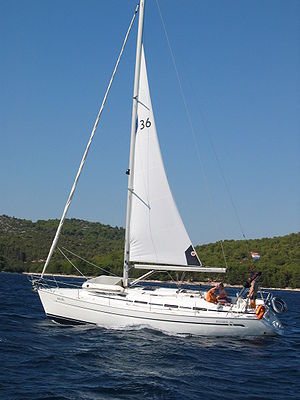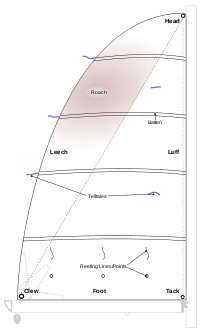
Reefing
Encyclopedia

Sail
A sail is any type of surface intended to move a vessel, vehicle or rotor by being placed in a wind—in essence a propulsion wing. Sails are used in sailing.-History of sails:...
on a sailboat
Sailboat
A sailboat or sailing boat is a boat propelled partly or entirely by sails. The term covers a variety of boats, larger than small vessels such as sailboards and smaller than sailing ships, but distinctions in the size are not strictly defined and what constitutes a sailing ship, sailboat, or a...
or sailing ship
Sailing ship
The term sailing ship is now used to refer to any large wind-powered vessel. In technical terms, a ship was a sailing vessel with a specific rig of at least three masts, square rigged on all of them, making the sailing adjective redundant. In popular usage "ship" became associated with all large...
, which can improve the ship's stability and reduce the risk of capsizing
Capsize
Capsizing is an act of tipping over a boat or ship to disable it. The act of reversing a capsized vessel is called righting.If a capsized vessel has sufficient flotation to prevent sinking, it may recover on its own if the stability is such that it is not stable inverted...
, broaching
Broach (sailing)
A sailboat broaches when its heading suddenly changes towards the wind due to wind/sail interactions for which the rudder cannot compensate. This causes the boat to roll dangerously and if not controlled may lead to a capsize...
, or damaging sails or boat hardware in a strong wind. Modern sailboats often combine reefing and furling
Furl (sailing)
Furling refers to stowing or dousing a boat's sail by flaking , packing , roller furling or just lowering it onto the deck. Nowadays, it is becoming more common to use the term "furling" to refer to reefing a sail that is part of a roller furling system....
of sails, as shown in fully furled Genoa
Genoa (sail)
The genoa or jenny was originally referred to as the 'overlapping jib' or the Genoa jib, being named after the city of Genoa as explained below. It is a type of large jib or staysail used on bermuda rigged craft that overlaps the main sail, sometimes eliminating it. It is used on single-masted...
headsail
Headsail
A headsail of a sailing vessel is any sail set forward of the foremost mast. The most common headsails are staysails, a term that includes jibs and the larger genoa...
of the Bavaria 36
Bavaria Yachtbau
The Bavaria Yachtbau GmbH is a German major yacht builder, with its headquarters in Giebelstadt, Bavaria, Germany. The model range consists of both sailing and motor yachts, of which especially the sailing yachts are very common. With ca. 600 employees, ca...
in the image at right.
There are three common methods of reefing: conventional, roller, and jiffy. The latter two make sail-handling easier and allow reefing to be done with fewer crew members.
Conventional reefing

Cringle
A cringle is an eye through which to pass a rope. In nautical settings, the word refers to a small hole anywhere along the edge or in the corner of a sail, rimmed with stranded cordage and worked into the boltrope. Typically it encloses a metal grommet for reinforcement and to reduce wear...
s, called reef points, may be placed above the foot of the sail. Tying the sail to the boom at these reef points forms a new tack and clew, reducing the sail's area. More than one row of reef points increases options for possible sail area. To perform the reef, a crewman must pull the reefing line as another crewman is lowering the sail. Reefing is used mostly when the winds are too strong and are overpowering the boat and the steering.
Roller reefing
Roller reefing involves rolling or wrapping the sail around a wire, foil, or sparSpar
In sailing, a spar is a pole of wood, metal or lightweight materials such as carbon fiber used on a sailing vessel. Spars of all types In sailing, a spar is a pole of wood, metal or lightweight materials such as carbon fiber used on a sailing vessel. Spars of all types In sailing, a spar is a...
to reduce the sail's exposure to the wind. The mainsail is wrapped around the boom
Boom (sailing)
In sailing, a boom is a spar , along the foot of a fore and aft rigged sail, that greatly improves control of the angle and shape of the sail. The primary action of the boom is to keep the foot of the sail flatter when the sail angle is away from the centerline of the boat. The boom also serves...
, which contains a mechanism in the gooseneck
Gooseneck
The gooseneck is the swivel connection on a sailboat by which the boom attaches to the mast. The boom moves from side to side and up and down by swiveling on the gooseneck....
that rolls in the sail—or special hardware inside the boom or mast is used to reef the sail by winding it around a rotating foil. These latter systems are known as mainsail furling systems. Conventional roller reefing on a rotating boom can be difficult and time-consuming, typically requiring a crew member to work at the mast in heavy weather. By comparison, furling systems operate easily through control lines led to the cockpit. Roller reefing allows a more gradual and controllable method of reefing than conventional or jiffy reefing.
Jiffy reefing
Jiffy reefing, also called slab reefing or single line reefing, is quicker and easier than conventional reefing or conventional roller reefing and involves folding the sail in sections, or slabs, along the boom. One or two reefing lines placed through the reef cringles at the sail's luff and leach edges are used to pull those points down tight to the boom, creating a new tack and clew for the sail. Reefing lines can be led back to the cockpit, and crew members can perform reefing without going on deck in heavy weather. In jiffy reefing there is no need to tie to the boom at the reef cringles on the sail. The equipment for jiffy reefing is often integrated with Dutchman flaking, a furlingFurl (sailing)
Furling refers to stowing or dousing a boat's sail by flaking , packing , roller furling or just lowering it onto the deck. Nowadays, it is becoming more common to use the term "furling" to refer to reefing a sail that is part of a roller furling system....
technology that flakes (or folds up) the sail on alternate sides of the boom rather than on a messy pile on one side of the boom.

